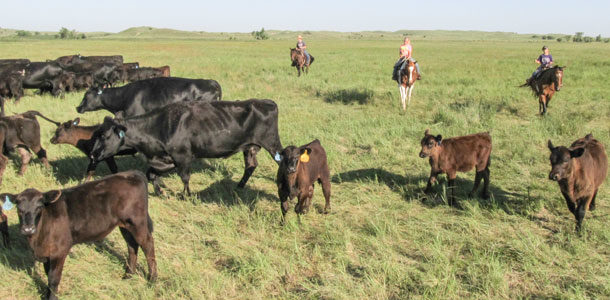Although he initially began with the mindset to become a cow-calf producer, he didn’t let certain situations deter him from his ranching goals – even if it meant doing something a little different.
In 2002, Marshall was approached by his in-laws to take over the family ranch near Burwell, Nebraska. A lease arrangement had previously been made with an area producer to keep 150 cows year-round and fill the ranch in the summer with nearly 300 cows. But the finances just weren’t there – making the first few years extremely tough on the Marshalls.
“We were really close to being out of business and finding work elsewhere,” Marshall says. “I realized something would have to change if I wanted to stay in the ranching business for much longer.”
Not wanting to stray from his goals, Marshall tried several different things over the years – he leased two different groups of cattle, started haying as a separate enterprise and bought his own herd hoping to increase profit margins. But none of these enterprises created the revenue he needed. After attending multiple grazing conferences and becoming involved with the Ranching For Profit School, Marshall started crunching numbers and realized that there were better options considering the assets he had already available.
With his existing acreage and current location, Marshall decided to make the transition into a custom-grazing operation. He figured that with 3500 acres he could accommodate close to 500 cows and run a successful enterprise because of the demand for custom grazing in the Sand Hills area.
For cell grazing to work efficiently, Marshall learned that he needed at least eight to 10 paddocks per herd to stop overgrazing, 14 to16 to increase animal performance and 30 or more to improve the ground. He decided to divide his acreage into 32 to 34 paddocks to achieve his business goals.

“When I started to understand the benefits of cell grazing and how I could run more cattle – it is basically like running another ranch for free,” he says. “We were able to nearly double the amount of cattle we could run. And at times, I have actually run more than the 500 pair.”
He says that his cell grazing system helped his business stay afloat during the severe drought in 2012. Even though he had to cut his cattle numbers back to 400 pairs to allow for recovery, there was still an ample amount of grass to graze.
“You have to be smart about things. I think the reason we have been successful is, for one thing, we had to figure out something or we weren’t going to survive in business as it was going. The other thing was I have been willing to learn and try some things,” he says. “It is also not listening to the neighbor saying you can’t do that. Just because they aren’t doing it doesn’t mean it can’t be done,” says Marshall.
Marshall points out that he didn’t grow up ranching. At a young age, he decided that was something he wanted to do and spent a lot time with relatives and friends with ranching roots. He believes that growing up that way allowed him to be open to changes and new management practices.
“If you want things to change, you’re going to need to change something,” he says. “Custom grazing may have not been my first choice, but it was something that worked. It is not a complex thing. So for someone with not a lot of experience in these things, it was something that fit me very well. Now I feel like I can move on to some other things with a little greater risk.”
Next year, Marshall plans to set aside his custom-grazing business for an arrangement to lease his current customer’s cattle. By doing this, Marshall has figured that if he stockpiles grasses for the winter and adds a protein supplement to their diet, he will be able to reduce feed costs and time caring for the herd. He also has in mind to move the calving date to May to allow for the grass to green-up and match each cow’s needs in the last trimester of pregnancy.
Marshall believes that he will always have a custom-grazing business, but this next change will help him take advantage of the high cattle prices. “To be successful you have to be open to change,” he says, “even if it places you somewhere you weren’t expecting.” FG
PHOTOS
TOP: The Marshall kids bringing up the rear as they move cattle through their allotted paddocks. They try to do most of their moves horseback.
BOTTOM: The Marshall family: Kyle, Kristen, Trent (13), Chloe (11) and Cody (7). Photos provided by Kyle Marshall.












